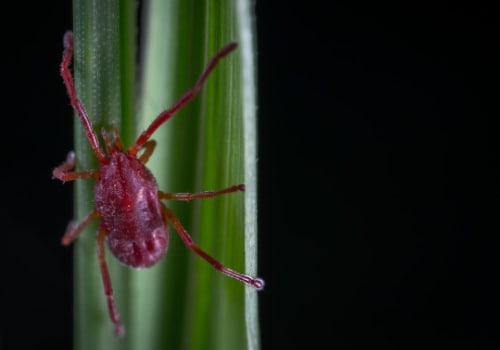Mites and other blood-sucking insects can pose a very serious threat to your flock’s health and safety, with health effects ranging from itchy or scaly skin to anemia and even death. Fortunately, both the prevention and the cure to an infestation of mites are relatively easy, and they all come down to keeping your chickens clean. So long as you keep your coop clean and carefully inspect each new chicken before introducing it to the flock, you should be able to keep your chickens mite-free, healthy, and happy!
What Are Mites, Exactly?

The word mite is a broad name that can apply to a number of small insects, but in the context of chickens, usually refers to any variation of the Dermanyssus Gallinae, the scientific name for chicken/poultry mites. Poultry mites are ectoparasites, which means that their life cycle depends on them drawing nutrients from and ultimately harming their host animal. While they prefer to feed on chickens, they will also bite other animals, including humans, so keeping your chicken coop mite-free will go a long way towards making sure that everybody in the area is clean, too.
Poultry mites can be sorted further into five categories:
- Northern Fowl Mites: the most common mite in the United States, the northern fowl mite can cause a dramatic drop in egg production if left untreated. They prefer a temperature around 65 to 68 degrees Fahrenheit, which means an infestation is far more likely to appear during cool, wet winter months. Unlike other mites, northern fowl mites spend their entire life cycle on the host, which makes them particularly dangerous, as they are able to drain a significant amount of blood from the chicken before dying.
- Red Roost Mites: red roost mites are the most common mites in Europe, especially in Western Europe. Unlike northern fowl mites, red roost mites prefer to live off the host animal, hiding in the chickens’ roost, and will only bite humans or animals other than chickens as a last resort. Unfortunately, red roost mites can be very difficult to eradicate, as they can survive for up to ten months without taking blood from a host.
- Scaly Leg Mites: a particular threat to chickens with long feathers around their legs, scaly leg mites, as their name suggests, burrow beneath the leg scales of affected chickens, which can lead to scaly-looking legs and feet and slow, painful walking. These mites are usually seen in Northern Europe, particularly the United Kingdom, but can be found anywhere their host animals have traveled.
- Depluming Mites: similar to the above, depluming mites burrow beneath the host chicken’s skin to attack a specific area of skin, but, unlike scaly leg mites, depluming mites primarily attack the shafts of the chicken’s feathers. The depluming mite gets its name from the reaction it provokes from the affected animals, as the confused and frightened chicken will often pull out its own feathers in an attempt to stop the pain and irritation.
- Tropical Fowl Mites: found in warmer climates like South America, the southern United States, and Australia, the tropical fowl mite is related to the northern fowl mite but differs in that it can and will successfully establish a human infestation, instead of preying only on chickens.
How to Tell If Your Chickens Have Mites?

The biggest issue with mites or other insects like lice is that they’re very difficult to see with the naked eye, and so an infestation can escape the first inspection. In general, in order to keep an eye out for an infestation in your flock, you should perform regular inspections, check the feathers, watch for unusual behavior, and provide a way for your chickens to stay clean and tidy.
- Perform Regular Inspections: at least twice a month, take the time to inspect your chickens for any signs of infestation. Because mites are so small, you most likely will not be able to see the insects themselves with the naked eye, but you can look for several telltale signs of their presence. Look for bald spots in your chickens’ feathers, redness or scabs on the skin, feathers that look dull or ragged, or clumps of dead skin around the bases of the feathers. You may be able to see mite eggs, as they are usually laid in clusters, but the more obvious signs will be physical changes to the host animal.
- Watch For Unusual Behavior: since the presence of mites is highly uncomfortable for chickens, keep an eye out for any behavior that seems out of the ordinary. Chickens may refuse to go into the coop at night, since mites are nocturnal and more likely to attack in the dark, which can make your chickens fear the place where they usually sleep. As mentioned earlier, chickens who are hosting depluming mites will often pluck at or tear out their own feathers in an attempt to stop the irritation, and chickens who are affected by scaly leg mites will develop a slow, halting walk in order to not increase irritation of the affected area. In general, any unexplained behavior that indicates physical distress in your chickens may be a sign of an infestation, and should prompt a closer inspection.
- Watch For Physical Changes: this last category of signs includes changes in the chicken’s physical appearance or actions that are clear even without inspection. If a chicken suddenly experiences a sharp drop-off in egg-laying, or is rapidly losing weight for no clear reason, this may be an indication that the coop is infested, and should be dealt with accordingly.
How Do Chickens Get Mites?

As scary as mites may sound, the good news is that they cannot just appear out of nowhere. Mites can only be transmitted to your coop from another infected host — in some cases, from an infected chicken that’s new to your flock, or else from wild birds in the area.
In order to prevent a new chicken from introducing mites to your flock, carefully inspect a new bird before letting it mingle with the other chickens. In addition, before introducing a new bird, spray your coop with a mixture of dish soap, cooking oil, and water in a ratio of 1 tablespoon dish soap to 1 cup cooking oil to 2 cups of water. This will coat any surfaces where the mites could hide, and keep them from nesting in an undiscovered nook or cranny. Spraying the coop after bringing in the new bird will also suffocate any mites that may have left the bird and keep them from laying eggs.
Preventing wild birds in the area from transmitting mites may be more difficult, as you obviously can’t inspect them as closely as you can your chickens. Instead, the best way to keep wild birds from spreading an infestation is to make sure that the area around your coop is cleared of wild nests, or enclosing the area where your chickens feed, so that wild birds can’t join them while they eat.
Finally, providing a shallow, dusty area where chickens can “dust bathe” at their leisure will make sure that their feathers stay clean and healthy. The dust strips away excess oils from chicken feathers, and the abrasion of small rocks and dirt particles will usually be enough to dislodge any parasitic insects.
[amazon bestseller=”chicken dust bath”]
How to Get Rid of Mites?

Once you know for sure that your chickens are dealing with mites, taking care of the problem becomes a matter of utmost importance. While stopping the infestation isn’t impossible, the old adage that “an ounce of prevention is worth a pound of cure” is as true with chickens as it is in any other situation, and the best way to deal with an infestation is to make sure it never sets in to begin with. However, if it’s too late to prevent an infestation, there are still several ways to tackle the problem at hand.
- Pesticides and Commercial Products: this may seem like an obvious solution, but there are lots of commercial pesticides available for purchase at any pet supply store that can help you treat your infected chickens. Spray the affected region to kill off any bugs that are laying eggs around your coop and keep them from attacking your flock. Diotemaceous earth, a naturally occurring dust-like material, can also be used to effectively kill any mites that are on the birds, but watch out to make sure that the cloud of dust doesn’t affect your chickens’ breathing. Try placing your chickens’ bodies in a soft cloth bag partially filled with DE, leaving the head free, and shaking gently to spread the dust all the way down to the roots of all their feathers.
[amazon bestseller=”Diotemaceous earth”]
- Natural Remedies: however, if you don’t want to use chemicals or commercial products to treat your mite problem, you can certainly try a natural remedy. Mites are known to display a natural aversion to herbs like lavender, wormwood, and mint, so using these herbs can clear off mites in addition to making your coop smell wonderful! Some stronger natural remedies include garlic or neem oil, which have a strong repellent effect on most insects and can help keep your coop clear of mites. However, while these natural products will help deter mites from entering the coop, they may not be as effective as chemical products in driving away the mites that have already taken up residence on or around your chickens.
- Bedding: once you’ve determined that your flock is being plagued by mites, cleaning or otherwise destroying their bedding is a crucial step in getting your chickens back on the road to clean health. Because most breeds of mites take shelter in the flock’s bedding during the day, getting rid of infested bedding can go a long way towards getting rid of the problem. If your flock roosts on straw or other natural materials, you can burn the affected bedding to make sure that no mites escape. If your flock roosts on a synthetic material, or if you don’t feel comfortable with building a bonfire out of bedding, dispose the affected material as far away from the coop as possible, and make sure that it is sealed away tightly, so that no mites can escape.
- Heat: related to the previous entry, heat is one of the surest ways to destroy an infestation of mites. Because mites tend to prefer temperate climates, they can seem to be everywhere during cooler months, but this still gives you an advantage in the fight against infestation, since, as a general rule, chickens can handle much higher temperatures than most varieties of mites can. Once your chickens are safely out of the way, increase the temperature of your coop to above 75 degrees Fahrenheit (or as high as possible) to dehydrate and kill any mites that may have taken shelter in the building itself. Fire, of course, will also kill any bugs that are hiding in the coop, but be careful not to harm the coop itself or any surrounding structures.
[amazon bestseller=”chicken coop heater”]
- Temporary Relief: if you’ve spotted an infestation, but are unable to deal with the affected animals immediately, there are still ways to provide a measure of temporary relief for your chickens. Standard anti-flea or anti-tick shampoos are usually meant for dogs but can be sprayed lightly over the chickens to drive-away the mites currently on their bodies and stop the itching and irritation for a little while. Again, it should be noted that this is only a temporary solution, and will not be enough to completely clear your flock of mites and solve the mite problem in the long run. However, as a way of soothing your chickens until you’re able to tackle the infestation completely, it can help keep them calm and prevent them from injuring themselves or other chickens.
[amazon bestseller=”anti-flea shampoo for chicken”]
- Last Resorts: most of the solutions listed above should be enough to treat an infestation if it is caught soon enough, but, in some cases, the infestation is caught far too late to be effectively treated. If you have been battling a mite infestation for months on end with no success, it may be time to consider destroying the coop where your chickens currently live. Burn the standing structure and construct a new one once you’re sure that all mites have been destroyed.
An important thing to keep in mind when dealing with mites is that an infestation can happen to anyone. Even the cleanest coop can be struck by a single infected bird, and an infestation is not necessarily a sign of poor care or dirty conditions. If you find yourself facing poultry mites, don’t let it discourage you, but take care of the problem as quickly as possible, so that your chickens will be feeling happy and healthy again.





That’s a scary sucker